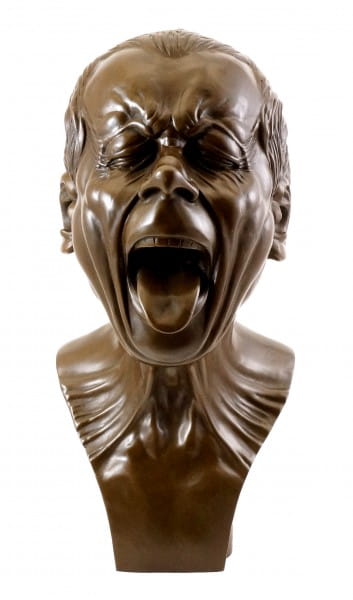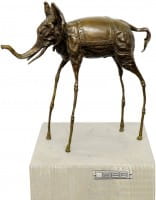Prices incl. VAT, free shipping worldwide
Ready to ship today,
Delivery time appr. 3-6 workdays










Product description
"Head with a stretched out tongue - Franz Xaver Messerschmidt"
| Height | 39 cm |
| Width | 21 cm |
| Length | 21 cm |
| Weight | 5,5 kg |
The Anatomy of Inner Agony - Bronze Head with a Stretched Out Tongue - Signed X. Messerschmidt
The sculpture presented here, Bronze Head with a Stretched Out Tongue, is one of the most startling and expressive faces in the extended canon of Franz Xaver Messerschmidt Art Works. The features are contorted in an impossible grimace: eyes squeezed shut, brow violently creased, neck muscles straining like taut cables, and the tongue extended in raw, primal revolt. It is neither scream nor yawn nor laugh—it is a paradox made flesh. The expression evokes both inner torment and biting defiance, and it belongs squarely to Messerschmidt’s deeply personal system of Kopfstücke, or head pieces, which he pursued obsessively in the last decade of his life.
From Wiesensteig to Pressburg: A Life Beyond Reason
Franz Xaver Messerschmidt was born on February 6, 1736, in the small German town of Wiesensteig, nestled in the Swabian Alps. He would go on to become one of the most complex and enigmatic sculptors of the 18th century. Trained at the Academy of Fine Arts in Vienna and influenced by both Baroque virtuosity and Enlightenment rationalism, Messerschmidt stood at the intersection of order and excess, beauty and distortion. His early career flourished in Vienna with imperial commissions and official portraiture, but after 1774, his life took a dramatic turn. Suffering from chronic digestive illness and possibly mental distress, he retreated to Pressburg (today’s Bratislava), where he entered the most unconventional and visionary phase of his artistic life. It is in this final period that the iconic Franz Xaver Messerschmidt Sculptures—known as the Character Heads—emerged, challenging the boundaries of expression, anatomy, and sanity itself.
A Head Without Name, Yet Full of Identity
What distinguishes this head from traditional portraiture is its absence of biography. It is not a likeness of a patron, saint, or noble—it is a psychic mask drawn from within. This deliberate anonymity marks a turning point in the history of sculpture. Whereas earlier art glorified status or virtue, Franz Xaver Messerschmidt turned inward. Each head became a study of the human condition unmoored from context. The head with the protruding tongue may not represent anyone, but it reveals everything: fear, disgust, resistance, ridicule, even ecstasy. It is impossible to decode and impossible to forget.
A Bronze Surface That Vibrates with Tension
Cast in warm, dark bronze, the surface of the head is smooth and eerily lifelike. The polish contrasts with the violence of the expression, drawing attention to every crease, every twitch of muscle, every tension in the jawline. The eyes are tightly sealed yet full of pressure. The tongue, disturbingly realistic, confronts the viewer directly. Here, form becomes emotion—anatomy becomes expression. It is this sculptural alchemy that defines Franz Xaver Messerschmidt Sculptures, whose technical perfection never exists apart from their psychological intensity.
A System Rooted in Suffering and Obsession
Messerschmidt claimed that he created these heads as part of a personal “system of exercises” to ward off an evil spirit he called the “Spirit of Proportion,” which he believed tormented him at night. He reportedly studied his own face in the mirror while inducing muscular contractions, and sculpted each contortion from memory. Whether viewed as a form of psychological self-therapy, proto-expressionism, or empirical anatomy, these heads form one of the most astonishing bodies of work in European art. The Bronze Head with a Stretched Out Tongue is one of the most extreme and theatrical in the series—a grotesque masterpiece that pushes even Messerschmidt’s eccentric methods to their limit.
The Character Heads: A Series Beyond Classification
This work belongs to a legendary corpus of over 52 busts known as the Charakterköpfe, or Character Heads. While not all survive, and many are unsigned or dispersed, the coherence of the series lies in their shared obsession with facial expression pushed to extremes. Some sneer, others grimace, smirk, or cry. This head, with its radically extended tongue and furrowed brow, is perhaps the most shocking of them all. It captures what critics, historians, and psychoanalysts have long admired in Franz Xaver Messerschmidt Art Works: the capacity to externalize states of mind in pure physiognomy, bypassing all conventional narrative.
The Sculptor Who Looked Inward While the World Looked Away
In his lifetime, Messerschmidt was both celebrated and feared. His early success in Vienna was overshadowed by rumors of eccentricity and illness. His retreat to Pressburg marked both exile and liberation. There, he gave up on commissions and devoted himself entirely to this strange, self-contained sculptural pursuit. Alone and possibly suffering from schizophrenia or a neurological condition like Meige’s syndrome, he created heads not for fame, but as companions, as mirrors, as defenses. It is this radical solitude and artistic purity that make Franz Xaver Messerschmidt not just a historical figure, but a timeless visionary.
The Tongue as Symbol of Defiance
Among all the heads, this one’s protruding tongue stands as a gesture of rejection and refusal. It breaks the solemnity of sculpture, mocks the viewer, and disrupts the boundary between dignified art and grotesque truth. The tongue is infantile, animal, obscene, and very human. In this sense, the Bronze Head with a Stretched Out Tongue is not merely about anatomy—it is about confrontation. The viewer is not invited to admire but to wrestle with meaning, ambiguity, and discomfort.
A Head That Refuses to Be Forgotten
The Bronze Head with a Stretched Out Tongue by Franz Xaver Messerschmidt is not just a sculpture—it is a psychological event. It does not offer answers but demands reaction. It stares into the abyss of the self and dares us to do the same. In the world of Franz Xaver Messerschmidt Sculptures, this head stands among the most disturbing and unforgettable—proof that in distortion lies truth, and in madness, perhaps, a deeper form of clarity.
Our advantages
free shipping
Worldwide free shipping
14 days money back
You can cancel your order
within 14 days
secure payment services
Paypal, Master Card, Visa, American Express and more









































